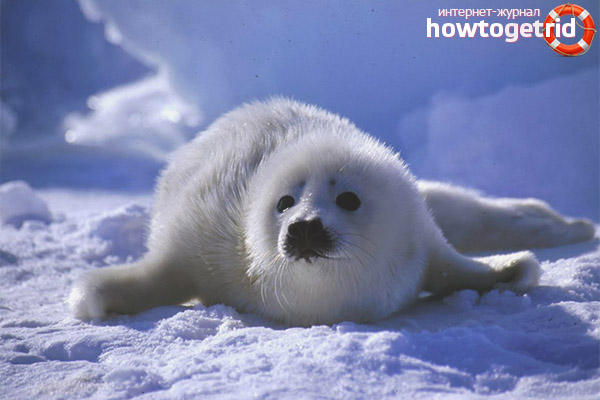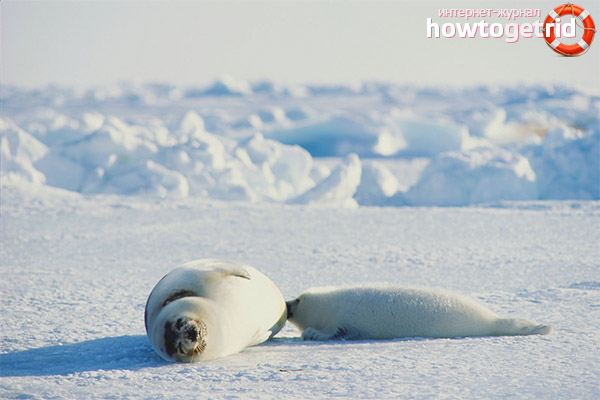The content of the article
One of the largest species of the seal family is Greenland. An adult weighs up to 160 kg. The body length of the male and the female is almost the same and approximately 1.80 m. The Greenland species has a typical seal-shaped body with a fairly long neck. Its interception is noticeably pronounced. On the muzzle there are dark gray vibrissae with densified wavy edges. Adult harp seals have a hard hairline. Hair length is insignificant, awns prevail in fur.
Seals change the color of their fur coats repeatedly at different ages. After baby fur, young animals become spotty-gray, with dark spots randomly scattered throughout the body of different sizes and outlines against an ashen background. From 5 to 7 years old they wear this robe. Further, the animal becomes an adult with the corresponding appearance: the head is black, the neck, back, chest and belly are of a light shade. From the shoulder blades in the direction of the tail, on the sides, capturing the edges of the back, two black spots in the pterygo-shaped form stretch along the body. The color of these “wings” is different for males and females. In males, they are black and shiny, in females, they are brown and non-shiny. This color is called the winged.
Habitat and distribution
The harp seal lives in the very north of the Atlantic Ocean, in the waters of the Arctic basin. He lives in the White, Barents Seas, in the west of the Kara Sea, where the waters are adjacent to the Novaya Zemlya archipelago. The northern boundary of the place of distribution of this species of seals is on Svalbard Island, from where it reaches the Severnaya Zemlya through the Franz Josef Land archipelago. From the west, the border of the habitat zone occupies the Norwegian Sea from the north, the coastal zone of Iceland from the north, the east coast of Greenland, St. Lawrence Bay, Newfoundland Islands further captures the southern extremities of Greenland. The animal is often found in the straits of Lancaster, Hudson, Wellington, Davis, Barrow.
Seals living in different parts of the range are distinguished from each other by some morphological characters. On this basis, two subspecies of harp seals were identified: eastern and western. But subsequent studies led scientists to the conclusion that it is more correct to distinguish within a single species not subspecies, but populations: three herds, isolated from each other, whose names depend on the place of predominant habitat (White Sea, Yanmein, Newfoundland).
The Yanmayen herd breeds on the island of the same name, then migrates to the south-west and north-east of it. Summertime feed near East Greenland. Seals are located on a vast space reaching the Danish Strait. In autumn, the population migrates back.
The Newfoundland herd of seals leaves the place of molting and puppies in late April.Moving north, animals migrate through the ice region of the Hudson Bay, then Baffin Island, the Davis Strait, and the straits of the Canadian Arctic Archipelago. In autumn, animals migrate back in two ways. One part of the herd, which was located in the Canadian Arctic archipelago, flows through the Baffin Land and the Hudson Strait, the second moves along the western coast of Greenland. Near the Labrador, both groups meet and swim together to molt areas.
Seal Feeding
In summer, harp seals consume more food than in winter. During this period they are in the northernmost zone of their habitat.
As food, the animal needs fish and small invertebrate inhabitants of the sea. Among the fish, saiga are most preferred; it is eaten year-round. In addition to saiga, seals hunt for saffron cod, cod, capelin and pollock. Rarely do pinnipeds ’diet consists of sea bass, flounder, herring and gobies. In addition to fish, seals also catch squids, mollusks, cuttlefish, black eyes and shrimp. The objects of seal hunting are characterized by great crowding; they do not swim alone. Cubs of seals, when they switch to adult food, begin to get used to planktonic crustaceans.
Breeding and development of seals
Female harp seals, before whelping, emerge from the water onto the ice and form baby pools. Each population has its own deposits on large, durable ice floes with many cracks, streaks, with several holes. Sometimes such places occupy several hundred square meters.
Seals have different times for seals in different areas. Females of the White Sea herd mainly produce offspring within 10 days from late February and early March. A small number of births do not fit these days and occur before or after the puppy period. Harp seal pregnancy lasts 11 to 11.5 months.
A newborn baby seal weighs 7-8 kg and has a body length of 80 cm. It is covered with long, thick hair of white color with a greenish tint, hence its nickname "Zelenets". A few days after birth, the color becomes white (squirrel), it grows 15 cm in length and increases in weight to 18 kg. Milk feeding of the cubs lasts 3 weeks; by this age, the squirrel gradually molts and turns into hohlush. Its length in this period is more than a meter, and weight - about 30 kg. At the age of one month, the calf independently descends into the water and begins to eat adult food. Its further growth is not so rapid.
The puberty of females occurs at the age of 4-5 years, individual individuals can mate at three years and later 5 years. Males mature by 6-7 years of life. For the most part, sexually mature females have cubs each year until they reach 25-30 years of age. The mating ability in males lasts up to the same age. Seals live up to the age of 40 (maximum).
Behavior features
Harp seal is an animal with a strong herd instinct. His way of life is not connected with being on land, his element is water and ice. Life consists of constant migrations within its range. For the period of the birth of the cubs, females form large rookeries. Pregnant individuals prefer to be located on the ice on the edges, only sometimes in the center. In ice, loopholes are often arranged to access the sea. Males in such rookeries appear towards the end of the period of feeding the babies. In small groups they are located separately from the females. Next comes the mating period, males move to the rookery of females. After molting, the entire herd of animals of different ages and sex are found together. During this period, animals are passive, they rarely go to sea, spending more time lying on ice.
During migration, seals form small groups, moving in schools.
Fishing value
For the first time, the number of seals of the White Sea herd was calculated using aerial photography in 1928, then it amounted to about 3.5 million individuals. Subsequent intensive fishing led to a significant reduction in the number of seals. In order to restore the population, the state imposed restrictions on the fishing of seals: temporary bans, limits, and the term of production was limited.
Currently, the hunting period for the pinnipeds of the White Sea population is legally limited, a ban has been imposed on the production of their baby calves, and the number of animals harvested is limited at the permitted time.











Submit